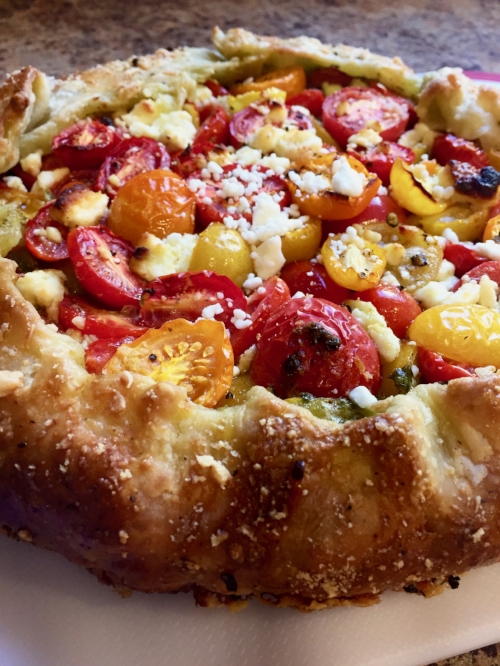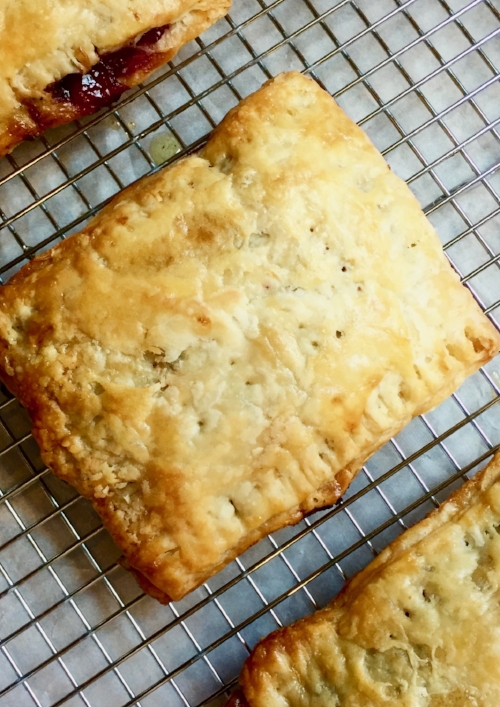Ridiculously Flaky, All Butter Pie Dough

Raspberry Peach Galette made with this Ridiculously Flaky, All Butter Pie Dough
I am going to make a bold statement.
I hate pie.
To be precise, I abhor piecrust. My entire life, I have eaten mediocre pie after mediocre pie, with flavorless crusts that contain delicious insides. Soggy little bottoms hidden under glistening fruits, creamy custards, and the travesty of terrible crust texture made me wonder why even bother with the crust in the first place?
Store-bought piecrust tends to taste like limp cardboard, and I do not find them to be particularly flaky or tender as so many pie devotees have declared to be decadence. Perhaps I have always been an unfortunate victim of having received underbred piecrust, for in particular the texture always seems very…soft, doughy, and utterly unappealing.
The Caramel. Apple Pie that changed my mind about piecrust, and my first pie made from scratch!!
But I yearned for years to make peace with piecrust. To extend a sugar coated olive branch, wave a yellow flag of friendship and accept the dastardly little piece of pastry dough into my life. After all, there had to be a reason so many others loved that little lifejacket for delicious fillings. I knew, somehow, I could discover the secret to that fabulously crispy, yet flaky contrast to a cool custard or gelatinous fruit filling in the world of pie. I was getting tired of just sneakily enjoying lonely little puddings or jams, rather than a full fledged dessert.
For me, this recipe is the golden light filled with flashing fireworks at the end of a long, arduous tunnel of the despondently limp, flavorless piecrust years. Forget lard, forget add in spices, this piecrust developed by Deb at Smitten Kitchen is absolutely brilliant with good old butter. It seems to take a very traditional route to assemble the piecrust, and I’ve very slightly adapted her method and I use salted butter rather than unsalted. This recipeyields a piecrust that is practically puff pastry. It’s crispy and flaky and the butter infuses every particle of flour used. I have tried this in both savory and sweet applications, and think it works beautifully in both.
Literally, after the first bite of this piecrust I put down my fork and thought "Ahh. I now understand that I was the misguided one all these years" and then was both simultaneously blissful about my discovery and felt immense pity for my younger self. The pastry is rich and decadent, but not too rich to detract from whatever Filling it is paired with. The butter sings through and flavors the flour delicately with the mix of salt and sugar. The very cold butter helps create flakes in the crust, similar to puff pastry. It continues to hold its crisp yet softens ever so slightly the next day and melds with the filling without becoming soggy. It, for me, is perfection, and I never thought I would say that about a piecrust.
A savory application for the Ridiculously Flaky, All Butter Pie dough in the form of a Tomato, Caramelized Onion, Pesto, Parmersan and Feta Galette.
This post will be short but sweet, as is the list of ingredients, but I will leave you with a few notes I’ve picked up from playing with this piecrust.
I make this by hand, and do not use a pastry cutter nor a food processor. This allows me to really get the feel of the dough with my fingers and also allows for slightly uneven chunks of butter, which I feel assists in crating those flaky layers that are a cousin to puff pastry.
I cut my butter into smallish chunks and then freeze them for 10 minutes or so while I get the rest of the ingredients ready. My reasoning for this is twofold, as I want to prevent melting the butter as much as possible while mixing the dry ingredients together with the butter and also I find it cuts down considerably on time spent incorporating the butter into the flour mixture. The quicker you are, the less the butter melts, which ultimately will help you create flaky pastry.
I almost always use an egg wash on this dough before baking, as I feel it helps crisp the outside and creates a more beautiful browned color while baking. If you sprinkle sugar or parmesan or whatever else as an added touch, the egg wash also helps them to stick better to the pastry in the finished product.
This may be a personal preference thing, but I have found that many recipes online that call for bake times of only 20 minutes for mini pies or even 40 to 50 minutes for a pie tend to be too short and the piecrust is not quite done. It may be that I prefer my piecrust slightly over baked, or maybe my oven is calibrated little cooler than the original recipe author's oven, but I’d recommend using the time listed in the recipe as your “start checking for doneness” point rather than just pulling whatever you’re making from the oven.
Lastly, you can roll this piecrust out straight from the fridge. Again, this allows the butter to stay cold and create steam and layers in the pastry as it cooks. What I do is roll out my piecrust on a big piece of parchment paper with flour, which helps with transferring it as well as keeping your counter clean. With every recipe I have tested, I also pop my prepared and filled pastry back in the fridge for about 15 minutes to cool the butter before placing in the oven.
Recipe testing Adult Cherry, Apricot, and Crystalized Ginger Pop Tarts with Ridiculously Flaky, All Butter Pie Dough.
Ridiculously Flaky, All Butter Pie Dough
Slightly adapted from Deb at Smitten Kitchen
Servings: 2 9 inch piecrust
Truly, this piecrust is the cousin of a puff pastry with the layers of flakiness that are created by the very cold butter. I think the texture is why this particular piecrust has appealed to my palate so much, in addition tothe fact that it uses butter because the flavor is amazing.
I have used this piecrust in pies, galettes both savory and sweet, and pop tarts. The amount of sugar used is just enough to lend itself to sweet pastries, but not sweet enough to have it be unusable for savory endeavors. This is perfect for me as I know I do not want to root around and try and figure out which frozen piecrust is sweet or savory in my freezer!
Ingredients:
- 2 1/2 Cups All Purpose Flour
- 1 Tbsp Granulated Sugar
- 1 Tsp Sea Salt
- 1 Cup (2 Sticks) of Salted Butter, cubed and very cold
- 1/2 - 3/4 Cup very cold Water
Directions:
- Take the butter and cube it into about 1/2 inch chunks. I do this by cutting it several times lengthwise and then chopping those into smaller pieces. Then place the whole cutting board full of butter in the freezer to chill for about 10 minutes.
- While the butter is getting extra cold in the freezer, take a a large bowl and whisk together the flour, sugar, and salt.
- Once the butter has chilled, combine it with the dryingredients. Use your hands, and quickly break the chunks into slightly larger than pea size pieces with the flour. They do not have to be uniform in size but evenly distributed and incorporated in the flour mixture.
- Add 1/2 cup of the very cold water and mix together with a wooden spoon. The mixture will start to form a shaggy ball, but may need some additional moisture to incorporate everything. If you find there is too much loose flour with only 1/2 a cup of water, add in up to an additional 1/4 cup of water one tablespoon at a time.
- Divide the dough into two equal pieces and wrap in Saran Wrap. You can shape them into little flattened disks to help your future rolling out endeavors.
- Chill in the fridge for a minimum of 2 hours. This will allow all of the water to redistribute through the dough and ultimately will make the dough more flexible and pliable for rolling out.
- If not using piecrust dough immediately, you can store in fridge for up to a week or in the freezer for up to two months. If you freeze the dough, remove and place in fridge to slowly defrost the night before using. This allows the butter to stay as cold as possible before baking.



